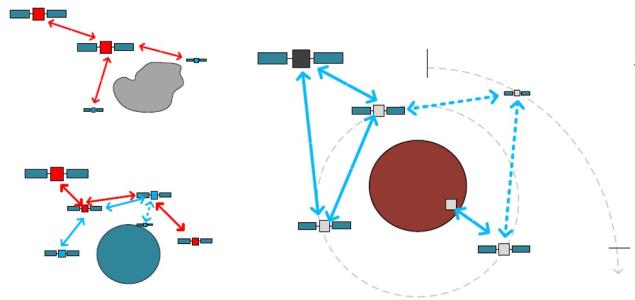Open Standard for Inter Satellite Link
Programme
TDE
Programme Reference
T706-602ES
Prime Contractor
QiNETIQ LTD.
Start Date
End Date
Status
Closed
Country
United Kingdom

Objectives
To develop an open standard for Inter Satellite Link (ISL), enabling different developers to enter the market and providing advantages to system integrators thanks to a larger pool
Description
A number of missions are being investigated, under development or even already flying that use the concept of multiple spacecraft interconnected with an intersatellite Link (ISL); they are mainly nano/smallsats (Proba-3 and Gomex-4a/b as current generation examples and AIM/HERA as future non-LEO case) but with clear interest also for regular mission. The only standardised protocol for such radio links is Proximity-1 that is however tailored for different applications (mainly data relay among landers and orbiters in a reduced complexity network topology with only limited accuracy for the line-of-sight ranging estimation).
Advanced solutions have been however investigated and (partially) developed on the basis of proprietary solutions in the frame of various RD contracts (ESA or not) and to provide specific products for private/national missions. The adoption of such proprietary solutions (often kept confidential to public) is seen as a limitation for the full exploitation of such constellation/formation concept, for example for heterogeneous/progressively deployed systems developed by different industries. It also prevents the development of reusable products.
This activity is meant to define requirements (functional, performance and I/F) and give recommendations for an open ISL protocol (RF, not optical, up to Layer 4) that allows implementations from different developers to be able to be part of the same network thanks to a common standard and to allows system integrators to gain from a more competitive ISL market. While the intended "market" is the European one, any coherent solution will be proposed to CCSDS. A small proof of concept (software simulator) will be produced.
The ISL system shall be able to support bidirectional data exchange, 1D/3D localisation, relative attitude determination and time correlation/synchronisation in a tailorable fashion to best match specific mission needs.
The activity encompasses the following tasks:
- gathering of contextual data, state of the art, existing solution, and requirements for the future ISL to be fully interoperable.
- protocol development
- software simulator proof of concept development
Application Domain
Generic Technologies
Technology Domain
6 - RF Subsystems, Payloads and Technologies
Competence Domain
3-Avionic Systems
Initial TRL
TRL 2
Target TRL
TRL 3
Achieved TRL
TRL 3
Public Document
Final Presentation
